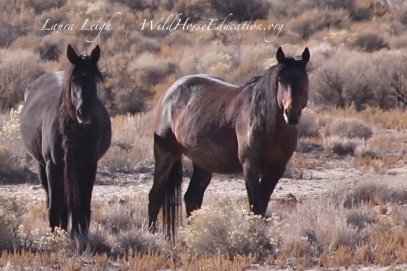As with any issue surrounding wild horses and burros controversy and propaganda reproduce more than flies in a hot barn in August.
At present Wild Horse Education is active in the pursuit of the use of birth control and data collection on the range. The simple purpose is to slow (and hopefully stop) wild horses and burros heading into holding facilities as data is collected on the ground to assess scientifically, management plans and change those plans through appropriate process to preserve and protect wild horses free on the range.
A significant lack of data has left wild horses and burros vulnerable to other interests as they fight for control of public land. Those battles have intensified due to drought and pending Sage Grouse plans that are broad sweeping. One such attack is the Nevada Association of Counties (NACO) litigation aimed at removing wild horses and even destroying them on the range and in holding to reduce numbers of wild horses. http://wildhorseeducation.org/2014/01/15/naco-suit-asks-court-to-order-destruction-of-wild-horses/
In June of 2013 the National Academy of Sciences (NAS) released a report on the BLM Wild Horse and Burro Program. http://wildhorseeducation.org/2013/06/05/nas-report-a-first-look/ This 400 page report essentially fails the program on a lack of scientific justification for any decision making.
Prior to the filing of the NAS report we filed litigation surrounding the Owyhee Complex in northern Nevada in January of 2013 http://wildhorseeducation.org/2014/10/28/owyhee-litigation-moves-forward/ The case is based on inhumane treatment AND a lack of data to justify any removals. The NAS report cites and supports our exact allegations in the Owyhee Complaint.
The NAS report is currently under review by BLM to determine how they will translate that report into recommendations. One of the core recommendations was birth control and data collection.
HOWEVER those recommendations will be made as multiple land use plans define Appropriate Management Level (AML) under the law. The accuracy of asserted AML is absolutely suspect, but real nonetheless. In order to change AML data must be present. In order to adjust boundary lines data must be present.
BLM uses the term “overpopulated.” That term means that wild horse or burro populations exceed AML. That is all it means. It does not validate that there are too many horses. It simply means that there are more wild horses on a range than a land use plan prescribed. A land use plan that we know was not based on data. BUT it is an enforceable number because it is the operational standard.
WE use the term “overcrowded.” Wild horses and burro ranges are utilized by multiple entities that create artificial and impeded use of wild horse Herd Management Areas (HMA). There are too many users crowding the horses.
So how do you deal with both terms? The distinction in meaning becomes rather irrelevant to the steps required to rectify the situation that is at the core of the “crisis” of 50,000 wild horses sitting in holding facilities and our western ranges being used as a “disposable” resource.
Using birth control (as recommended by the NAS and advocated for years by those trying to protect wild horses) creates the need to gather utilization data. How do the wild horses and burros use the range? What might be critical habitat to their survival? What is the herd structure? What is the genetic bank involved and how fast is it depleted? Is distribution an issue due to improper boundary lines and limited water sources?
All of those questions can be answered in site specific fashion. In each area an equation can then be developed to determine exactly what is “AML” and adjust those that are not based on anything but “what is left over” after other uses (like massive livestock use or water use). The resources required to protect those populations (as the law intends) will be identified so that their preservation can be fought for.
Either way you look at it “overpopulation” or “overcrowded” the steps forward to create actual preservation of resource and wild horses and burros are identical. KNOWING the range and the herds that occupy them, based on scientific evaluation of actual data, will erase the game of “too many horses” simply because someone says so. It will erase the accusation of “you don’t know anything, my family has lived here for a hundred years.” It will create management based on an actual truth.
PZP is NOT sterilization. Sterilization techniques are the “options” being discussed by those wanting horses off the range permanently. Hysterectomies, overectomies and gelding are techniques being proposed by those claiming PZP does not work. There is a herd in Idaho where we are likely going to see a “non reproducing” herd become a reality in the very near future through surgical techniques. Those pushing for this option are well organized and well funded. Sterilization closes door forever that can not be reopened and will destroy any pretense of preservation of our herds.
DATA is missing in this conversation as land use plans must be changed to reflect an actual truth that is complete. We are working hard to create that for our wild ones. It is not easy and will require an intense amount of manpower and resource as teams will be needed in every area to implement every step of the process to uncover the “truth.” The opposition comes from all sides of the fence.
We need to get back to the field… there are horses that are going to be removed… again.
~~~
Categories: BLM, Keep Them in the Wild, Owyhee, Roundup Reality, Wild Horse Education

You must be logged in to post a comment.